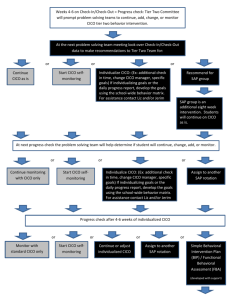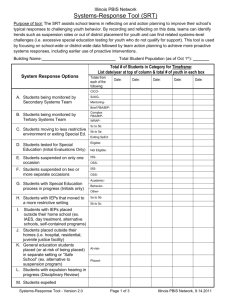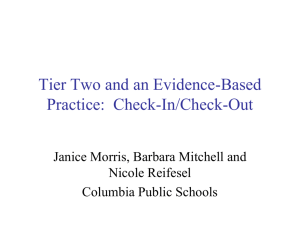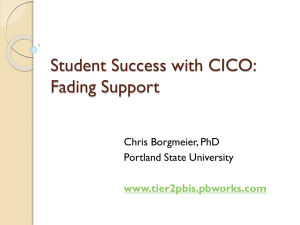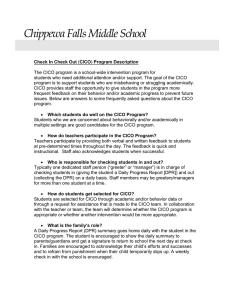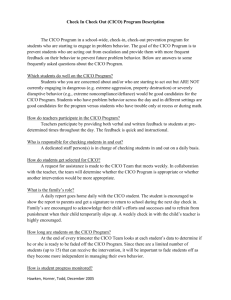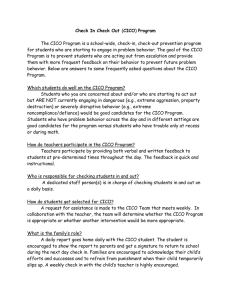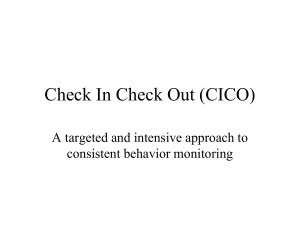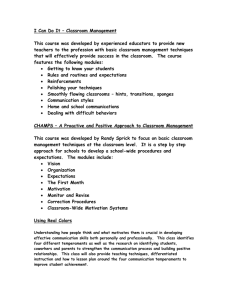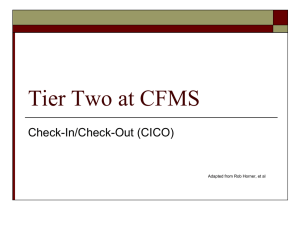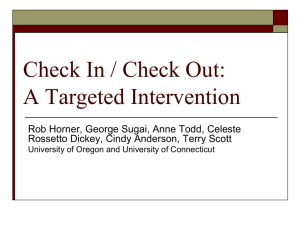Check In and Check Out with Data Systems
advertisement
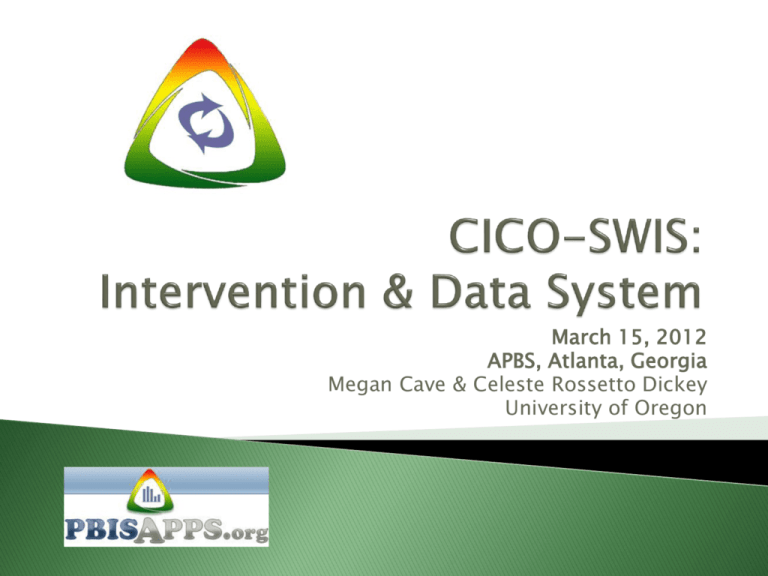
March 15, 2012 APBS, Atlanta, Georgia Megan Cave & Celeste Rossetto Dickey University of Oregon What is CICO? Check & Connect? Behavior Education Program? Hello, Update & Goodbye? The CICO-SWIS Application Using Data for Decision Making Questions Dr. Rob Horner, Anne Todd & Celeste Rossetto Dickey University of Oregon All specialized interventions are more effective, and more durable, if they are done with school-wide behavioral expectations as a foundation. ◦ ◦ ◦ ◦ Check & Connect Hello, Update & Goodbye (HUG) Behavior Education Program Other names SCHOOL-WIDE POSITIVE BEHAVIOR SUPPORT ~5% ~15% Primary Prevention: School-/ClassroomWide Systems for All Students, Staff, & Settings Tertiary Prevention: Specialized Individualized *Systems for Students with High-Risk Behavior Secondary Prevention: Targeted Interventions *Systems for Students with At-Risk Behavior ~80% of Students SCHOOL-WIDE POSITIVE BEHAVIOR SUPPORT ~5% ~15% Primary Prevention: School-/ClassroomWide Systems for All Students, Staff, & Settings Tertiary Prevention: Specialized Individualized *Systems for Students with High-Risk Behavior Secondary Prevention: Targeted Interventions *Systems for Students with At-Risk Behavior TODAY ~80% of Students Everyone on staff knows about it ◦ Easy access and quick implementation ◦ Substitute teachers and volunteers included Always available ◦ no individual changes necessary Home school connection ◦ Regular reporting of progress Skills are taught and used ◦ Shape into self management skills Improved structure Prompts are provided throughout the day for correct behavior. System for linking student with at least one positive adult. Student chooses to participate. Student is “set up for success” First contact each morning is positive. “Blow-out” days are pre-empted. First contact each class period (or activity period) is positive, and sets up successful behavioral momentum. Increase in contingent feedback Feedback occurs more often. Feedback is tied to student behavior. Inappropriate behavior is less likely to be ignored or rewarded. Program can be applied in all school locations Elevated reward for appropriate behavior Linking behavior support and academic support Linking school and home support Program is organized to move towards a selfmanagement system Classroom, playground, cafeteria (anywhere there is a supervisor) Adult and peer attention delivered each target period Adult attention (and tangible) delivered at end of day For academic-based, escape-maintained problem behavior incorporate academic support Provide format for positive student/parent contact Increased options for making choices Increased ability to self-monitor performance/progress Faculty and staff commitment Is problem behavior a major concern? Are staff willing to commit 5 min per day? Is CICO a reasonable option for us? More than 5 students need extra support Tier 2 interventions are designed to work with 10-15% of kids in a school CICO typically “works” with 67% of students needing Tier 2 interventions.. CICO does NOT replace need for individualized supports. Team available Team leader CICO coordinator (morning, afternoon) Team (meets at least once every two weeks) School-wide PBIS in place School-wide expectations defined and taught Reward system operating Clear and consistent consequences for problem behavior Process for identifying a student who may be appropriate for CICO Student is not responding to SWPBS expectations Request for Assistance Student finds adult attention rewarding Student is NOT in crisis. Daily CICO progress report card Same expectations for all Common schedule All staff taught rules for accepting, completing and returning the card. Home report process Can be same as progress card Can be a unique reporting form Application within SWIS Targeted Intervention Data Entry & Report Generation Daily Progress Report standard for all students in CICO Intervention Supporting Social Competence & Academic Achievement OUTCOMES Supporting Decision Making Supporting Staff Behavior PRACTICES Supporting Student Behavior Practices ◦ Define procedures ◦ Teach procedures ◦ Use daily point card for progress monitoring ◦ Communicate with home on student progress ◦ Acknowledge expected behavior ◦ Correct behavioral error (continuum of consequences) ◦ Use information for decisionmaking Systems Admin. Leadership Team-based implementation Defined commitment Allocation of FTE &Coordinator ◦ Budgeted support ◦ Development of decisiondriven information system ◦ ◦ ◦ ◦ Data: ◦ Data entry ◦ Report Generation ◦ Decision Making Student Recommended for Check In Check Out Check In Check Out (CICO-SWIS) CICO is Implemented CICO Coordinator Summarizes Data For Decision Making Morning Check-in Parent Feedback Regular Teacher Feedback Bi-weekly Meeting to Assess Student Progress Afternoon Check-out Revise Program Exit Program Goals 8:30-10 1011:30 Lunch 12-1:30 1:303:00 Be Safe 0 1 2 0 1 2 0 1 2 0 1 2 0 1 2 Be Respectful 0 1 2 0 1 2 0 1 2 0 1 2 0 1 2 Be Responsible 0 1 2 0 1 2 0 1 2 0 1 2 0 1 2 TOTAL Comments:_____________________________________________________ Nine readiness requirements ◦ One of which is a SWIS account ◦ CICO program description ◦ Daily point card compatible with CICOSWIS data entry format 1. 2. 3. 4. 5. 6. Purpose of Targeted Intervention and expected student outcomes Student screening and selection to program decision rules and procedures Procedures for participating in the targeted intervention Procedures for training staff, students, families, transportation, substitute staff, others Data system for monitoring student progress Decision making cycle and people responsible Example Criteria for compatibility 1.Standard for all students? 2.3-5 school-wide expectations 3.3 point rating scale? 4.No more than ten check in periods? Apply these criteria to the following examples Example A 1. Standard for all students? CICO Record 2. 3-5 Name: ____________________________ Date: ______________ Expectations? 3 = great 2 = OK 1 = hard time 3. 3 point rating scale? Total Safe Responsible Respectful 4. No more than Points ten check in Period 1: 3 2 1 3 2 1 3 2 1 periods? Reading Period 2: Math 3 2 1 3 2 1 3 2 1 Period 3: Writing 3 2 1 3 2 1 3 2 1 Lunch 3 2 1 3 2 1 3 2 1 Period 4: Soc. St. 3 2 1 3 2 1 3 2 1 Period 5: Art/Music/PB 3 2 1 3 2 1 3 2 1 Today’s goal Comments: Today’s total points: Example B Name: Date: Block 1 Block 2 Block 3 Block 4 Safety 0 1 2 0 1 2 0 1 2 0 1 2 Organization 0 1 2 0 1 2 0 1 2 0 1 2 Achievement 0 1 2 0 1 2 0 1 2 0 1 2 Respect 0 1 2 0 1 2 0 1 2 0 1 2 Example C Name: Date: Pencil sharpened Homework completed Raise hand to Be on time talk Keep hands to self 1. Check in 2. 3. Music on MWF 4. PE on T TH 5. Math 6. Lunch 7. Recess 8. 9. Language arts 10. Snack 11. Research projects 1 2 3 4 1 2 3 4 1 2 3 4 1 2 3 4 1 2 3 4 1 2 3 4 1 2 3 4 1 2 3 4 1 2 3 4 1 2 3 4 1 2 3 4 1 2 3 4 1 2 3 4 1 2 3 4 1 2 3 4 1 2 3 4 1 2 3 4 1 2 3 4 1 2 3 4 1 2 3 4 1 1 1 1 1 1 1 1 1 1 1 1 1 1 1 1 1 1 1 1 1 1 1 1 1 2 2 2 2 2 3 3 3 3 3 4 4 4 4 4 1 2 3 4 1 2 3 4 2 2 2 2 2 3 3 3 3 3 4 4 4 4 4 1 2 3 4 1 2 3 4 2 2 2 2 2 3 3 3 3 3 4 4 4 4 4 1 2 3 4 1 2 3 4 2 2 2 2 2 3 3 3 3 3 4 4 4 4 4 1 2 3 4 1 2 3 4 2 2 2 2 2 3 3 3 3 3 4 4 4 4 4 1 2 3 4 1 2 3 4 1. Standard for all students? 2. 3-5 Expectations? 3. 3 point rating scale? 4. No more than ten check in periods? 1. 2. 3. 4. Standard for all students? 3-5 Expectations? 3 point rating scale? No more than ten check in periods? Name: Date: Daily Goal GOALS Points received _____ Daily goal reached? Yes No 8:30-10 Recess 10:1511:30 Lunch 12:151:15 1:15-3:00 Be Safe 0 1 2 0 1 2 0 1 2 0 1 2 0 1 2 0 1 2 Be Respectful 0 1 2 0 1 2 0 1 2 0 1 2 0 1 2 0 1 2 Be Responsible 0 1 2 0 1 2 0 1 2 0 1 2 0 1 2 0 1 2 TOTAL 1. 2. 3. 4. Standard for all students? 3-5 Expectations? 3 point rating scale? No more than ten check in periods? Name: Date: Daily Goal GOALS Points received _____ Daily goal reached? Yes No 8:30-10 Recess 10:1511:30 Lunch 12:151:15 1:15-3:00 Be Safe 0 1 2 0 1 2 0 1 2 0 1 2 0 1 2 0 1 2 Be Respectful 0 1 2 0 1 2 0 1 2 0 1 2 0 1 2 0 1 2 Be Responsible 0 1 2 0 1 2 0 1 2 0 1 2 0 1 2 0 1 2 TOTAL 1. 2. 3. 4. 5 Standard for all students? 3-5 Expectations? 3 point rating scale? No more than ten check in periods? The Total can make it easier for data entry. (Note: Convert if 1-2-3 scale) CICO-SWIS Individual Student Count Report What Questions? What Decisions? What Questions? What Decisions? What Questions? What Decisions? Individual Student Period Report What Questions? What Decisions? What Questions? What Decisions? Individual Student Single Period Report What Questions? What Decisions? Average Daily Points by Student Report School- Wide Report What additional questions would you have? Check In Check Out: The Intervention CICO-SWIS: Readiness & Application Using CICO-SWIS data to make decisions support@swis.org accounts@swis.org
